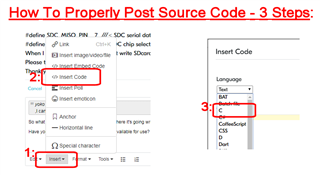I am looking at the APP_ERROR_CHECK and find out it finally goes to the app_error_save_and_stop method. I couldn't understand from the code, that where the error info saved and how I can look in those errors?
Thanks,
I am looking at the APP_ERROR_CHECK and find out it finally goes to the app_error_save_and_stop method. I couldn't understand from the code, that where the error info saved and how I can look in those errors?
Thanks,
Have you looked at the source code?
The documentation says it just enters an infinite loop:
Got it. It says: Function for saving the parameters and entering an eternal loop, for debug purposes. So, where those parameters saved?
Thanks
If you are talking about these codes as following, yes I did, but don't understand. Can u explain? Thanks,
void app_error_save_and_stop(uint32_t id, uint32_t pc, uint32_t info)
{
/* static error variables - in order to prevent removal by optimizers */
static volatile struct
{
uint32_t fault_id;
uint32_t pc;
uint32_t error_info;
assert_info_t * p_assert_info;
error_info_t * p_error_info;
ret_code_t err_code;
uint32_t line_num;
const uint8_t * p_file_name;
} m_error_data = {0};
// The following variable helps Keil keep the call stack visible, in addition, it can be set to
// 0 in the debugger to continue executing code after the error check.
volatile bool loop = true;
UNUSED_VARIABLE(loop);
m_error_data.fault_id = id;
m_error_data.pc = pc;
m_error_data.error_info = info;
switch (id)
{
case NRF_FAULT_ID_SDK_ASSERT:
m_error_data.p_assert_info = (assert_info_t *)info;
m_error_data.line_num = m_error_data.p_assert_info->line_num;
m_error_data.p_file_name = m_error_data.p_assert_info->p_file_name;
break;
case NRF_FAULT_ID_SDK_ERROR:
m_error_data.p_error_info = (error_info_t *)info;
m_error_data.err_code = m_error_data.p_error_info->err_code;
m_error_data.line_num = m_error_data.p_error_info->line_num;
m_error_data.p_file_name = m_error_data.p_error_info->p_file_name;
break;
}
UNUSED_VARIABLE(m_error_data);
// If printing is disrupted, remove the irq calls, or set the loop variable to 0 in the debugger.
__disable_irq();
while(loop);
__enable_irq();
}
So there you can see where the stuff is!

Thanks for the tip. But still you are answering me. I am still not clear. Can't you just give a direct answer?
Here:
static volatile struct
{
uint32_t fault_id;
uint32_t pc;
uint32_t error_info;
assert_info_t * p_assert_info;
error_info_t * p_error_info;
ret_code_t err_code;
uint32_t line_num;
const uint8_t * p_file_name;
} m_error_data = {0};How do I access it? just printf m_error_data?
How do I access it? just printf m_error_data?
Well, if you're in that place it means your system is in a mess; so printing may well be "disrupted" - as the comment says.
You could try it to see if it works.
If not, put a breakpoint in that function and examine the data using the debugger.
Failing that, save the data in a "safe" area of RAM that will survive a reboot. Then reboot, and print the info at startup.
How to setup a "safe" area of RAM that will survive a reboot depends on what tools you're using - which you haven't mentioned.
But these are pretty standard debugging techniques - not specific to Nordic - so some general googling should find the answer ...
EDIT
Here's an example for SES (also mentions IAR):
Got it. Thanks a lot.